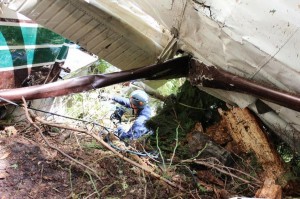
Three fatal light plane crashes in Alaska in recent weeks have highlighted safety concerns for commuter airlines. Hageland Aviation, part of Ravn Air Group, has established an innovative control system that monitors all flights in an effort to ensure safe travel.
Although Alaska’s bush pilots are legendary, and stories about them abound with accounts of tight landings and flying in extreme weather, bush carriers are always and increasingly focused on safety. One of the state’s largest commuter air lines, Hageland Aviation, has devised a unique control system that analyzes risks to ensure flight safety. It may come as a surprise that flights in the Yukon Kuskokwim region are directed from the other side of the state.
When Hageland flight operations agent Randy Hames, gives a Bethel pilot the go ahead for take off, Randy is no where near Bethel. She’s in a control room at the Palmer airport.
And no Hageland plane will be released for flight without the go ahead from Palmer controls.
Greg Tanner, Hageland’s operations control manager, says having flight decisions made from the center removes it from the business department and takes the burden of decision off the pilot’s shoulders.
“Pressure from customers that they are looking at face to face. This has removed that pressure completely from the pilots, because it is not their decision alone. They are still an integral part of the decision, but it’s not on their shoulders anymore, you know, when a customer is saying ‘ come on, I have to get home, it’s my son’s birthday, for crying out loud.'”
In the last year and a half, Hageland has worked to tighten it’s operations and maintenance programs based on decades of information, to create a unique tracking and control system, devised by Hageland to cover its average 950 flights a week. All of the flights are being directed from the Palmer control center .
“We’ve got our own company database, which was designed by Bob Hjdukovich and IT people over twenty years ago, and has been developed into what we have now to serve our operations.”
Tanner says commuter airlines, like Hageland, with planes carrying 9 seats or less, are allowed to created their own operations programs under FAA guidelines. He speaks as he shows guests around Hageland’s Palmer facility.
“We go over their aircraft status, and how many hours they may have flown yesterday and we look at the weather where they want to go. We are looking at the notices to airmen that the FAA puts out for those airport’s destinations, and we determine a risk assessment with the pilot regarding what level of risk we are going to assign to their
flight. ”
Flight risks are categorized according to hazards, with weather, runway conditions and human factors all figured in. A level three risk requires consultation with the chief pilot or operations director before the plane can be released. Flight releases are only good for 30 minutes. If the plane is not airborne by then, the risk has to be re-assessed.
Hageland has achieved a high standard for plane maintenance as well, through a computer system developed in -house. Mike Harris is Hageland’s maintenance director.
“We went down to Seattle for Alaska Airlines and we visited with their maintenance control for a couple of days. That’s where we got the ideas, from Alaska Airlines. We did our own software in-house. The IT department generated this software for us. So we have our own software that we maintain, manage. We have control over it.”
The computer program has a live status page to keep track on the immediate maintenance needs of each of the 58 planes Hageland operates.
Hageland has maintenance centers in Fairbanks, Bethel and Palmer. Hageland put it’s current operations and maintenance program into play in March of last year. Greg Tanner.
“So we’re the only company that I am aware of that has this level of scrutiny over every flight. “Hageland had a fatal crash near St Mary’s in November of 2013, resulting in four deaths. Another crash of a training flight last year took two lives.
Hageland Aviation, along with Corvus Aviation and Frontier Flying Service, does business under the Ravn Alaska name.
APTI Reporter-Producer Ellen Lockyer started her radio career in the late 1980s, after a stint at bush Alaska weekly newspapers, the Copper Valley Views and the Cordova Times. When the Exxon Valdez ran aground in Prince William Sound, Valdez Public Radio station KCHU needed a reporter, and Ellen picked up the microphone.
Since then, she has literally traveled the length of the state, from Attu to Eagle and from Barrow to Juneau, covering Alaska stories on the ground for the AK show, Alaska News Nightly, the Alaska Morning News and for Anchorage public radio station, KSKA
elockyer (at) alaskapublic (dot) org | 907.550.8446 | About Ellen




